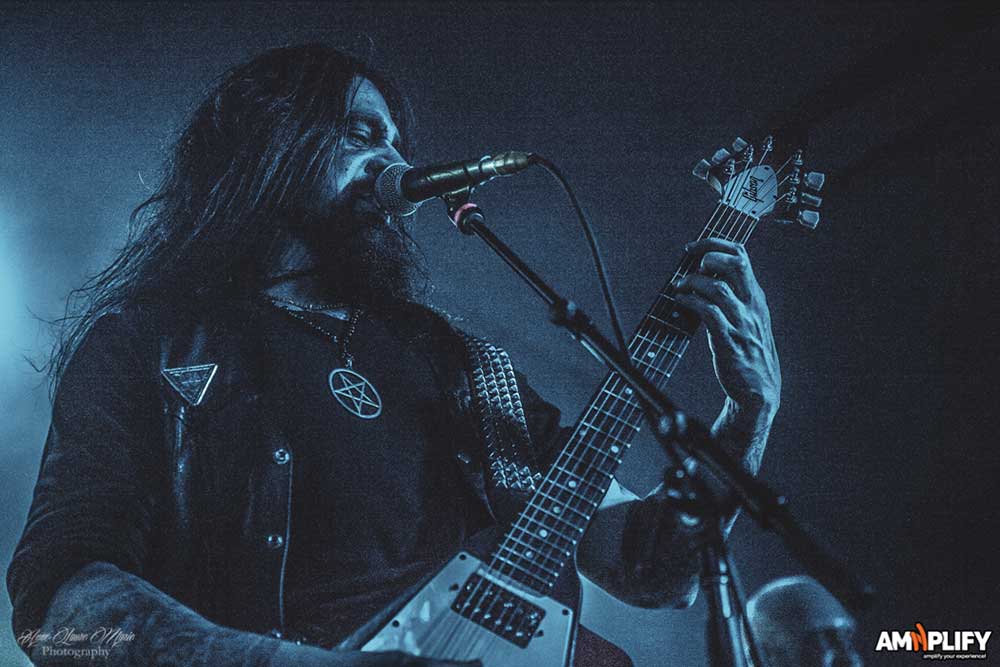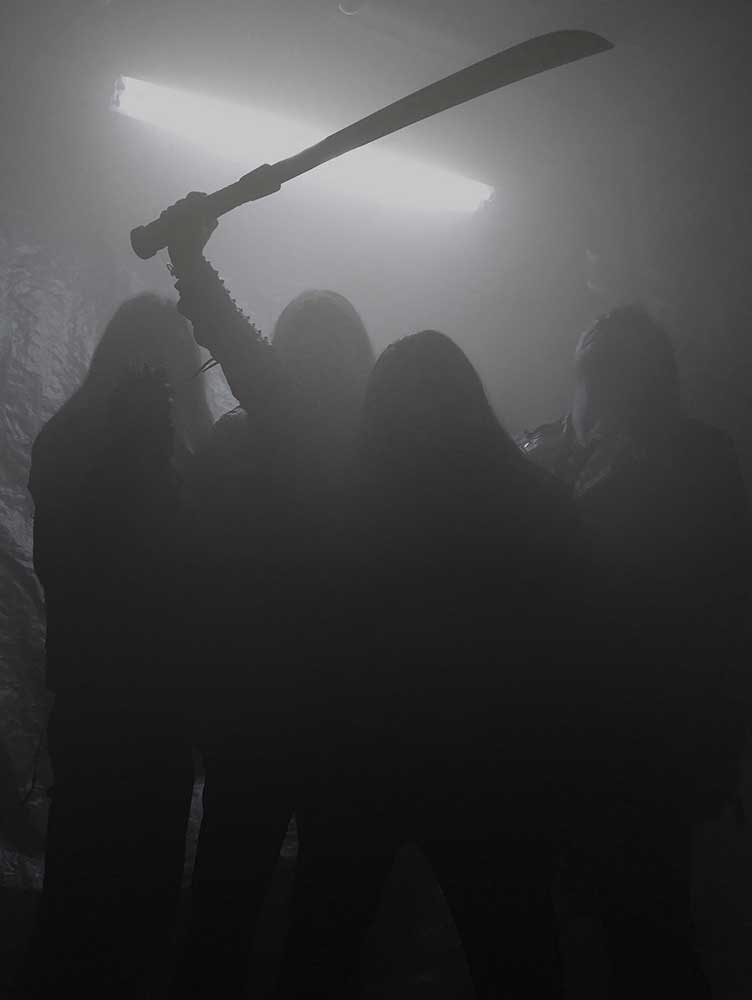Denouncement Pyre
2018-10-24
by Niklas Göransson
Burning hunger and black sun illumination – Australian black/death metal band Denouncement Pyre draw creative sparks from primal recesses of the human mind. Guitarist and vocalist D speaks of brain-warping frequencies and inspiration from chaos.
– Things have been steady, we’re always working on something. Recently, we’ve been rehearsing a couple of tracks for an upcoming mini-album scheduled for recording somewhere around the new year. Everything is still somewhat in the embryonic stages; while the material won’t be a direct continuation of “Black Sun Unbound” (2016), it’s hard to describe where these ideas will take us. All I’m certain of for now is of it being somewhat different – that’s the way we like to work. As for shows, this year we’ve only performed live twice; first with SABBAT from Japan here in Melbourne and then at the Malign Rites fest. We’re fairly picky about when, where, and with whom we play so that’s really nothing new or out of the ordinary.
D notes that there are a number of circumstances which must be just right in order for DENOUNCEMENT PYRE to reach their full potential in a live setting.
– It’s all about the energy we absorb from feeding off the crowd, the feel of the room as well as the dynamic between members on stage – all of which usually manifests as total rage during our performances. But then there’s something else I’ve experienced amongst this madness, something much more isolated, almost like an overbearing calmness where everything stops and you’re momentarily elsewhere. I mention this as strange because our shows are usually rather chaotic: an overload of adrenalin and ecstasy, loud as hell, piercing lights in your eyes and heaps of smoke. A real sensory overload, and then amongst it this strange sense of tranquil clarity appearing at times. There’s a momentary shift of headspace, a state I struggle to find the right words for describing.
Seeking to ease the facilitation of such a headspace, DENOUNCEMENT PYRE employ – as part of their intros and interludes – samples of non-metal musical elements such as traditional Tibetan throat-chanting and shamanic-inspired percussion.
– Acting as bridges between our own songs, they keep the atmosphere flowing throughout the entire performance. I like the idea of engaging with the crowd and introducing something beyond what most metal shows might involve. We feel that it enriches our performance, whether the audience is consciously aware of it or not. Also, over all three of our albums we’ve incorporated certain arrangements influenced by ritualistic approaches. If you check out tracks like “Wounds of Golgotha” or the ending of “An Extension of the Void”, they contain arrangements and ideas that speak to something beyond traditional metal – long repetitive passages, percussion, and so on.
Do you ever listen to such music outside of a metal context?
– My musical tastes are fairly varied so, naturally, this along with my interest in esoteric subjects has led me to traditional and modern ritualistic sounds and practices. Throat chanting can produce powerful tones as dark as anything heard in metal music. I imagine that as a performer, the power gained would be tenfold in comparison to what I experience as a listener. There are plenty of easily accessible modern interpretations of these primal sounds, like Vishudha Kali, SIGILLUM S, PHURPA, Zero Kama, etcetera. Listened to under the right conditions, it’s a different experience compared to what metal can offer but I believe the dark energy originates from the same source. Obviously, in this instance, it’s not so much about the arrangement or catchiness of the composition, like rock or metal music – instead totally based on atmosphere alone, which is a crucial component to the effects produced by such sounds. I’d say a lot of dark ambient works in a similar way.

Upon publishing the Cory Allen interview in August 2016, I’d spent the past few years ranting and raving about binaural beats to anyone I thought might be interested. When I met D during a 2015 visit to Melbourne, he was the only one who’d actually tried it.
– They’re valuable tools in the pursuit of different levels of awareness and consciousness. My first experience with binaural beats came back in my teenage years when a friend and I were messing around with sounds and frequencies meant to mirror the hallucinatory effects of different drugs. This was obviously before we could get our hands on other methods or substances to fast-track that particular process. Our intentions were somewhat naive back then but certainly cemented a foundation for exploring altered states of perception. Over time I’ve continued to experiment with increased focus and this has in turn strengthened the results. I find that using them late at night prior to sleep increases lucid dreaming and dream-recall. This is hard to describe but it’s like the part of normal waking consciousness remains fully aware of its surroundings whilst mind and body shuts down. When waking up, it’s as if I’ve barely closed my eyes yet I feel energetic and fully rested.
This I have not tried, any idea how it works?
– I think the experience is heightened because of adjustments in brain activity before and during the initial stages of sleep. It’s like a trance state in which you lose track of where regular waking consciousness stops and dreaming begins. I’ve used them under other circumstances too and it’s not always the same as the conscious dreaming state. Binaural beats are also a useful aid for meditation in that the right frequencies and focus can help to distance oneself from mundane awareness for a while. It has resulted in stages of great creativity, some of which have birthed ideas used for songs and lyrics. For example, “Deathless Dreaming” from “Black Sun Unbound” refers to that conscious dreaming state I mentioned – awareness which doesn’t cease in sleep and dreaming intertwined with full consciousness. The lyrics for the title track also draw inspiration from such experiences.
D speculates that truly inspired musical composition of the dark variety stems from the basal ganglia, or reptilian brain, which is the part of human neurology that regulates primeval functions such as emotion, impulses, and physical action.
– There’s no doubt that dark art and music appeal to those who are willing to delve into the deepest recesses of their mind. I’ve thought about why this is and where it comes from. The reptilian brain is concerned with survival, instinct and other base behaviours; all of which are concurrent with the metaphysical aspects of black metal that to me feed off a kind of primal intuition. I was drawn to black metal because it articulated my fascination for the shadow side – you can say esoteric, occult, and so on – as opposed to having picked up that interest as a result of the music. I was already in tune with these currents since a young age, so there was an immediate connection which has only intensified over time.

On the ageless conundrum of whether art imitates life or vice versa, D says he’d be inclined to believe them entwined and reflecting each other in both philosophy and action.
– The goal of the artist should surely be to experience both as one and the same. Any metaphysical ideas that exist within my own experience have always found their way into our creative output. While I wouldn’t say I’ve personally had any spiritual awakenings in direct conjunction with music, it’s certainly provided a soundtrack to various experiences over the years. Perhaps it’s helped feed my interest in all sorts of dark subject matter. The three DENOUNCEMENT PYRE albums in particular have more or less reflected the stages of the path I adhere to and where I’ve been at that time.
He says that the spring of intuitive creativity lies in an inner void, the darkness beyond all light. This, he continues, is chaos – a concept often referred to in their music as a source of inspiration.
– There are ideas sitting below the surface – the subconscious if you like – that lie dormant, waiting to be channelled and interpreted into something auditory. They reveal themselves only under the right circumstances. I find the best result for writing is focusing firstly on being in the right mindset and environment, really harnessing those conditions, and ideas tend to float to the surface from there. The same thing happens in the recording studio, it’s like a sudden ‘click’ between those present and an idea is born. It’s almost intuitive and, over time, we’ve become increasingly open to allowing those ideas to find their way into our creations and take on a life of their own. That’s when a song can completely transform into something it wasn’t intended to be; such are the results of dark forces at work.
Why do you think some have this ability while others are entirely void of creative talents?
– Most people have a remarkable ability to be consumed by absolute worthless shit; mundane habits that cause mental fatigue and drain energy. Spending hours in front of the television set, for instance, acts as a roadblock to inspiration. This is probably why most people are not creative and live most of their lives as rodents on a hamster wheel in perpetual pursuit of the repetitive, predictable, and mundane. Throw a spanner into that wheel and the wellspring tends to open itself up and respond kindly. That’s always worked for me, a little disruption to normal processes goes a long way. People who are artistically productive find a way to be present in the moment, which is how one captures an idea hovering outside normal awareness.
A common example pertaining to this logic of disconnecting the conscious mind from the creative process, one that doesn’t necessarily entail any form of artistry, is when pondering a problem over an extended period of time – many find their best ideas and solutions surfacing from the subconscious when the matter isn’t being actively contemplated.
– I’ve often had my creative peaks when distancing myself from all the purposeless shit. You need to be inspired and motivated. We often talk about that as wildfire, or a burning hunger. I generally try to surround myself with people and environments who feed creative energy, not drain it. The atmosphere where I live and write music reflects what I’m attempting to draw upon. My recording room is my temple, our stage banners hang in there permanently – charged symbols acting as gateways to that inner void I mentioned. Everything is designed so that when I enter, the outside world is left behind. Sincere expression, whether it’s music, visual art, or performance, tends to strike a chord with its audience as it appeals to them on a deeper level. Something drawn directly from spirit will probably also speak to the spirit. When modern man has no deeper level of awareness and his senses are dulled, creative forces are prone to fall on deaf ears.



